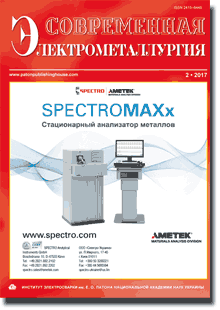| 2017 №02 (03) |
DOI of Article 10.15407/sem2017.02.04 |
2017 №02 (05) |

Electrometallurgy Today (Sovremennaya Elektrometallurgiya), 2017, #2, 21-28 pages
Producing of high-strength thermo-sensitive bimetal invar/copper foils by the method of electron beam deposition
A.I. Ustinov, S.A. Demchenkov, E.V. Fesyun
E.O. Paton Electric Welding Institute, NASU. 11 Kazimir Malevich Str., 03680, Kiev, Ukraine. E-mail: office@paton.kiev.ua
Thermosensitive bimetal foils, consisting of layers of materials with different coefficients of thermal expansion, are manufactured by rolling of these materials and their joining. The thermal sensitivity of foils is determined by materials, which are included in its composition and its total thickness. The traditional approach to the manufacture of bimetal foil implies limitations for its producing of a small thickness with a higher thermal sensitivity. The increase in strength of these foils is important from the point of view of a practical application. The work considers the possibility of manufacture of bimetal foils on the base on invar alloy Fe–Ni–Co and copper by electron beam deposition in vacuum per one technological cycle. To increase the strength of materials, included into bimetal foil composition, their deposition was performed at the condition of producing the layer of invar alloy Fe-Ni-Co in a nanostructured state and a copper layer with a nanotwinned substructure. It is shown that by varying the time of deposition of materials it is possible to produce the high-strength nanostructured bimetal foils of thickness from 20 up to 100 μm. Ref. 11, Table 1, Figures 8.
Keywords: electron beam deposition; vacuum condensates; bimetals; nanostructured materials; copper; invaralloy
References
1. Timoshenko S. (1925) Analysis of Bi-metal thermostats. Journal of the Optical Society of America, 11, 3, 233–255. https://doi.org/10.1364/JOSA.11.0002332. (2008) Kanthal thermostatic bimetal handbook, [Catalog 3-A-1-3 05-08-3000], Sweden, Hallstahammar, Kanthal AB.
3. Ustinov A. I., Demchenkov S. A., Polishchuk S. S.,Telychko V. A. (2014) Effect of deposition conditions of Fe100-xNix (30 < x < 40) condensates on their structure. Surface & Coating Technology, 251, 247–253. https://doi.org/10.1016/j.surfcoat.2014.04.033
4. Ustinov А. I., Polishchuk S. S., Demchenkov S. A., Petrushinets L. V. (2015) Effect of microstructure of vacuum-deposited Fe100-xNix (30 < x < 39) foils with FCC structure on their mechanical properties. Journal of Alloy and Compounds, 622, 54–61. https://doi.org/10.1016/j.jallcom.2014.10.039
5. Ustinov A. I., Fesyun E. V., Melnichenko T. V. (2007) Effect of substrate temperature on micro- and substructure of copper condensates deposited from a vapor phase. Advances in Electrometallurgy, 4, 18–24.
6. Ustinov A. I., Skorodzievski V. S., Fesiun O. V. (2008) Damping capacity of nanotwinned copper. Acta Materialia, 56, 3770–3776. https://doi.org/10.1016/j.actamat.2008.04.009
7. Firstov S. A., Gorban V. F., Pechkovsky E. P., Mameka N. A. (2007) Uravneniye indentirovaniya. Dopovidi Natsionalnoi akademii nauk Ukrainy, 12, 100–106. [in Russian].
8. Ignatovich S. R., Zakiev I. M., Borisov D. I. (2006) Material surface layer damage estimation for cyclic loading conditions using the nanoindenting and nanoscratching techniques. Strength of Materials, 38, 4, 428–434. https://doi.org/10.1007/s11223-006-0061-2
9. Milman Yu. V., Dub S., Golubenko A. (2008) Plasticity characteristics obtained through instrumental indentation. Materials Research Society Symposium Proceedings, 1049, 123–128.
10. Martynov V. V., Khandros L. G. (1975) Vliyaniye napryazheny na effekt pamyati formy v splave med–alyuminy–nikel. Fizika metallov i metallovedeniye, 39, 5, 1037–1042. [in Russian].
11. Angel G. D., Haritos G. (2013) an immediate formula for the radius of curvature of a bimetallic strip. International Journal of Engineering Research & Technology, 2, 12, 1312–1319.
